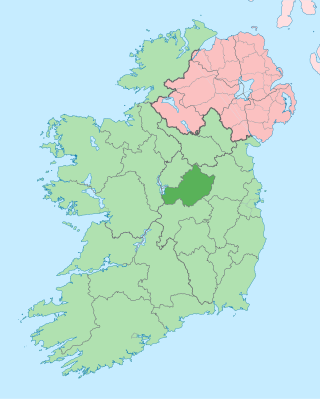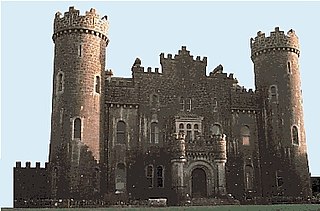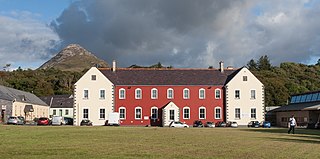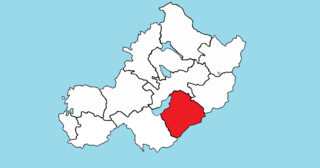Related Research Articles

County Westmeath is a county in Ireland. It is in the province of Leinster and is part of the Eastern and Midland Region. It formed part of the historic Kingdom of Meath, which was named Mide because the kingdom was located in the geographical centre of Ireland. Westmeath County Council is the administrative body for the county, and the county town is Mullingar. At the 2022 census, the population of the county was 95,840.

Drumcondra is a residential area and inner suburb on the Northside of Dublin, Ireland. It is administered by Dublin City Council. The River Tolka and the Royal Canal flow through the area.

Castlepollard is a village in north County Westmeath, Republic of Ireland. It lies west of Lough Lene and northeast of Lough Derravaragh and Mullingar.

Cavan is the county town of County Cavan in Ireland. The town lies in Ulster, near the border with County Fermanagh in Northern Ireland. The town is bypassed by the main N3 road that links Dublin with Enniskillen, Ballyshannon and Donegal Town.

Belvedere House and Gardens is a country house located approximately 8 kilometres (5 mi) from Mullingar, County Westmeath in Ireland on the north-east shore of Lough Ennell. It was built in 1740 as a hunting lodge for Robert Rochfort, 1st Earl of Belvedere by architect Richard Cassels, one of Ireland's foremost Palladian architects.

Tyrrellspass is a Georgian village in County Westmeath, Ireland. It is 81 kilometres (50 mi) from Dublin, in the south of the county on the R446 road. Tyrrellspass won the Irish Tidy Towns Competition in 1969. As of the census in April 2016, the population of Tyrrellspass was 483.
The Irish Church Missions (ICM) is a conservative and semi-autonomous Anglican mission. It was founded in 1849 as The Irish Church Missions to the Roman Catholics chiefly by English Anglicans though with the backing and support of Church of Ireland clergy and bishops, with the aim of converting the Roman Catholics of Ireland to Protestantism. The reference to Roman Catholics in the title was removed in 2001.
Knockcroghery is a village and townland in County Roscommon, Ireland. It is located on the N61 road between Athlone and Roscommon town, near Lough Ree on the River Shannon. The townland of Knockcroghery is in the civil parish of Killinvoy and the historical barony of Athlone North.

Tyrrellspass Castle, dating back to circa 1411, is situated in the town of Tyrrellspass, County Westmeath, Ireland. It is the only remaining castle of the Tyrrells, who came to Ireland around the time of the Norman Invasion.

Clonyn Castle also known as Delvin Castle, is a Victorian country house situated in Delvin, County Westmeath, Ireland some 18 km from Mullingar along the N52. It is a square, symmetrical, two-storey castle-like building of cut limestone with four tall, round corner towers at each corner. The interior has a large two-storey hall with a gallery and arcading. It was one of the last Victorian baronial castles to be built in Ireland.

The R446 road is a regional road in Ireland. The road connects Kinnegad in County Westmeath to Galway City. Prior to the construction of the M6 motorway the R446 formed the main N6 road connecting Dublin and Galway. Following the opening of the M6; the old N6 road was downgraded to regional road status and was designated as the R446. The road is an alternative route between Galway and Dublin and runs in parallel to the M6.

Veith House is an organization whose mission is to meet the needs of children, individuals and families, with empowerment as an ever-present goal. It is located at 3115 Veith St in the North End of the Halifax Regional Municipality, Nova Scotia, Canada. It is just down the hill from one of Halifax's landmarks, The Hydrostone.

Industrial schools were established in Ireland under the Industrial Schools (Ireland) Act 1868 to care for "neglected, orphaned and abandoned children". By 1884, there were 5,049 children in such institutions throughout the country. The Act was superseded by the Children Act 1908.
Porter-Leath, formerly known as the Children's Bureau, is a non-profit organization based in Memphis, Tennessee that serves children and families in the area. Porter-Leath was founded in 1850 as an orphanage and has since grown to six program service areas. The agency retains the early nature of its mission by providing foster care and has also expanded to early childhood education.
Bethany Home was a residential home in Dublin, Ireland mainly for Protestant unmarried mothers and their children, and also for Protestant women convicted of petty theft, prostitution, and infanticide. Most had a Church of Ireland background. The home was run and managed by evangelical Protestants, who, in the main, were Plymouth Brethren, Church of Ireland or Presbyterian. It catered to "fallen women" and operated in Blackhall Place, Dublin (1921–34), and then in Orwell Road, Rathgar (1934–72), until its closure. The home sent some children, some unaccompanied, to Northern Ireland, England, and to the United States.
Celbridge Collegiate School is a former charter school and Protestant girls school situated outside Celbridge in County Kildare in Ireland located 22 kilometres from Dublin. It was known as a nursery of teachers for the Church of Ireland training college and for the proficiency of the Irish language among students.
Westbank Orphanage was a privately run Protestant orphanage in Greystones, County Wicklow, Ireland, which closed in the 1990s. Westbank was originally founded as the Protestant Home for Orphan & Destitute Girls. It moved from Harold's Cross in Dublin to Wicklow in the late 1940s, and began to accept boys as well as girls. The regime at the orphanage was Protestant evangelical Christian and was run by Miss Adeline Mathers, a born-again Christian. While it attempted to find homes for some children with Protestant families, many were retained as helpers and as a means of raising funds. Some children were sent illegally to families in Northern Ireland, England, and Scotland. The orphanage became controversial when allegations of abuses surfaced. In the 1960s children from another related and equally controversial Protestant home, the Bethany Home, were transferred to Westbank. The orphanage was designated by the Church of Ireland and the state as place to send Protestant orphans. Westbank children were sent to worship in Bray Gospel Hall. The orphanage was run by the Westbank Greystones Protestant Orphanage Charity, associated with Bray Gospel Hall. It was registered as a charity and availed of tax benefits as a result.

Kirwan House or The Female Orphan House was a Church of Ireland-run female orphanage initially at 42 Prussia Street (1790-93), next on Dublin's North Circular Road (1793-1959) and latterly at 134 Sandford Road in Ranelagh (1959-87).

Fartullagh, previously Tyrrells country, is a barony in south–east County Westmeath, in Ireland. It was formed by 1542. It is bordered by County Offaly to the south and three other baronies: Moycashel, Moyashel and Magheradernon and Farbill.
Dublin Female Penitentiary, was a reform institution for "fallen women" in Dublin, Ireland. It established in 1810 and opened in 1813, it was run by the Church of Ireland and located between Berkeley Road, Eccles St. and North Circular Road. The Asylum could cater for over 40 inmates. It was administered by a Committee of ladies, for the religious and moral improvement of the women. While inmates were from all religious backgrounds, they had to adhere to the rules of the house and were instructed in the reformed faith. As with many protestant benevolent initiatives, many laywomen were involved. Mrs. Paulus Aemilius Singer of Temple Street, served as secretary of the committee, was a notable supporter of the institution. Penitents were employed in a laundry washing and mangling, and also needlework, hatmaking and mantua-making. As with other similar institutions the penitentiary was affiliated to a chapel. There was a Repository where the penitents' work was sold, with income used to fund the institution. After eighteen months places outside the laundry were sought for an inmate. Some inmates were sent to Queensland, Australia.
References
- ↑ Orphanage, Children's Home,Tyrrellspass, County Westmeath Buildings of Ireland.
- ↑ Hughes, Paul (24 June 2010). "A lot Dunne, more to do". Westmeath Examiner . Archived from the original on 31 May 2015.
- ↑ Calls for the conversion of orphanage to museum by Alison Healy, Irish Times, 21 July 2001
- ↑ Protected Structures Westmeath County Council Website.
- ↑ Renewed Efforts www.psssivehouseplus.ie